
Allegheny County is located in the southwest of the U.S. state of Pennsylvania. As of the 2020 census, the population was 1,250,578, making it the state's second-most populous county, following Philadelphia County. The county seat is Pittsburgh. Allegheny County is included in the Pittsburgh, PA Metropolitan Statistical Area, and in the Pittsburgh Designated Market Area.
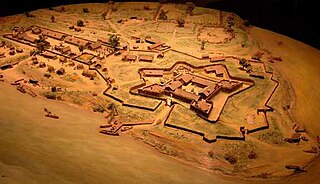
Fort Duquesne was a fort established by the French in 1754, at the confluence of the Allegheny and Monongahela rivers. It was later taken over by the British, and later the Americans, and developed as Pittsburgh in the U.S. state of Pennsylvania. Fort Duquesne was destroyed by the French, prior to British conquest during the Seven Years' War, known as the French and Indian War on the North American front. The latter replaced it, building Fort Pitt between 1759 and 1761. The site of both forts is now occupied by Point State Park, where the outlines of the two forts have been laid in brick.

Fort Prince George was an uncompleted fort on what is now the site of Pittsburgh, at the confluence of the Allegheny and Monongahela Rivers in Allegheny County, Pennsylvania. The site was originally a trading post established by Ohio Company trader William Trent in the 1740s. Construction of Fort Prince George, named for the crown prince and later King George III), was begun in January 1754 by 41 Virginians. The plan to occupy the strategic forks was formed by Virginia Lieutenant Governor Robert Dinwiddie, on the advice of Lieutenant Colonel George Washington, whom Dinwiddie had sent on a mission to warn French commanders they were on English territory in late 1753, and had made a military assessment of the site. Captain Trent commanded the force constructing the fort, but his men were captured by 1,000 French soldiers and Indians led by Claude-Pierre Pécaudy de Contrecœur. At the time of the French arrival, Trent was at Wills Creek for a conference, while his second-in-command, Lieutenant John Fraser, was at his own plantation at Turtle Creek on the Mononghela River. Ensign Edward Ward was left to surrender the fort on April 18, 1754. The French attack was the hostile act of the war, and it led to George Washington's own surprise attack at the Battle of Jumonville Glen.

The history of Pittsburgh began with centuries of Native American civilization in the modern Pittsburgh region, known as "Dionde:gâ'" in the Seneca language. Eventually, European explorers encountered the strategic confluence where the Allegheny and Monongahela Rivers meet to form the Ohio, which leads to the Mississippi River. The area became a battleground when France and Great Britain fought for control in the 1750s. When the British were victorious, the French ceded control of territories east of the Mississippi.

The Braddock expedition, also called Braddock's campaign or Braddock's Defeat, a failed British military expedition, attempted to capture the French Fort Duquesne in the summer of 1755, during the French and Indian War of 1754 to 1763. The British troops suffered defeat at the Battle of the Monongahela on July 9, 1755, and the survivors retreated. The expedition takes its name from General Edward Braddock (1695–1755), who led the British forces and died in the effort. Braddock's defeat was a major setback for the British in the early stages of the war with France; John Mack Faragher characterises it as one of the most disastrous defeats for the British in the 18th century.
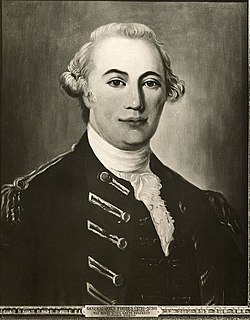
John Forbes was a Scottish professional soldier who served in the British Army from 1729 until his death in 1759.
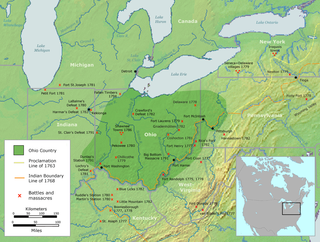
The Ohio Country was a name used in the mid- to late 18th century for a region of North America west of the Appalachian Mountains and north of the upper Ohio and Allegheny rivers, extending to Lake Erie. The area encompassed roughly northwestern West Virginia, Western Pennsylvania, all of the present-day state of Ohio, and a wedge of southeastern Indiana.

Downtown Pittsburgh, colloquially referred to as the Golden Triangle, and officially the Central Business District, is the urban downtown center of Pittsburgh. It is located at the confluence of the Allegheny River and the Monongahela River whose joining forms the Ohio River. The "triangle" is bounded by the two rivers. The area features offices for major corporations such as PNC Bank, U.S. Steel, PPG, Bank of New York Mellon, Heinz, Federated Investors and Alcoa. It is where the fortunes of such industrial barons as Andrew Carnegie, Henry Clay Frick, Henry J. Heinz, Andrew Mellon and George Westinghouse were made. It contains the site where the French fort, Fort Duquesne, once stood.

Michel-Ange Du Quesne de Menneville, Marquis Du Quesne was a French Governor General of New France. He was born in Toulon, France.
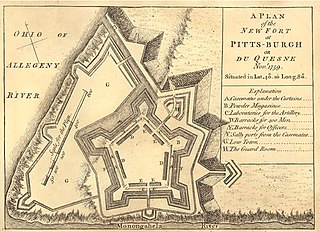
Fort Pitt was a fort built by British forces between 1759 and 1761 during the French and Indian War at the confluence of the Monongahela and Allegheny rivers, where the Ohio River is formed in western Pennsylvania. It was near the site of Fort Duquesne, a French colonial fort built in 1754 as tensions increased between Great Britain and France in both Europe and North America. The French destroyed Fort Duquesne in 1758 when they retreated under British attack.

Western Pennsylvania is a region in the U.S. state of Pennsylvania, covering the western third of the state. Pittsburgh is the region's principal city, with a metropolitan area population of about 2.4 million people, and serves as its economic and cultural center. Erie, Altoona, and Johnstown are its other metropolitan centers. As of the 2010 census, Western Pennsylvania's total population is nearly 4 million.
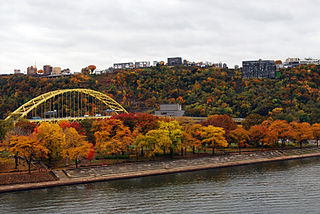
Point State Park is a Pennsylvania state park on 36 acres (150,000 m2) in Downtown Pittsburgh, Allegheny County, Pennsylvania, USA, at the confluence of the Allegheny and Monongahela rivers, forming the Ohio River.

The Battle of Fort Duquesne was British assault on the eponymous French fort that was repulsed with heavy losses on 14 September 1758, during the French and Indian War.
Ligonier Valley is a valley in Westmoreland County, Pennsylvania, United States.
Braddock's Field is a historic battlefield on the banks of the Monongahela River, at Braddock, Pennsylvania, near the junction of Turtle Creek, about nine miles southeast of the "Forks of the Ohio" in Pittsburgh, Pennsylvania. Here, in 1755, was fought the Battle of the Monongahela which ended the Braddock Expedition.
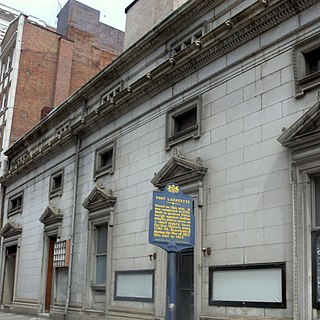
Fort Lafayette, later renamed Fort Fayette, (1792–1814) was an American fort in Pittsburgh, Pennsylvania, United States. It was constructed in June 1792 by Major General Anthony Wayne upon his commission to form the Legion of the United States.

The Forbes Expedition was a British military expedition to capture Fort Duquesne, led by Brigadier-General John Forbes in 1758, during the French and Indian War. While advancing to the fort, the expedition built the now historic trail, the Forbes Road. The Treaty of Easton served to cause a loss of Native American support for the French, resulting in the French destroying the fort before the expedition could arrive on November 24.
The following is a timeline of the history of the city of Pittsburgh, Pennsylvania, US.

Shannopin's Town, or Shannopintown, was an 18th-century Lenape (Delaware) town located within the site of modern-day Pittsburgh, Pennsylvania, along the Allegheny River, approximately two miles east from its junction with the Monongahela River. In the early 1700s, British colonial settlers began spreading into western Pennsylvania, forcing Lenape and other American Indian tribes to move further west, settling in the Ohio Country. Shannopin's Town was one of several communities established in western Pennsylvania in the 1720s. The town was largely abandoned during the construction of Fort Duquesne in 1754, although a small community still existed when General John Forbes' troops arrived in September, 1758. The community was gone by the time construction on Fort Pitt was started in 1759.
























